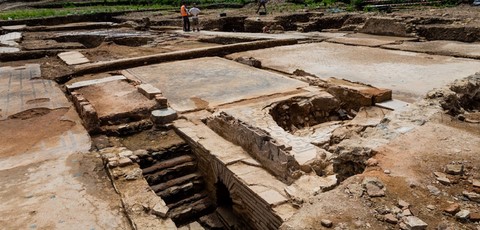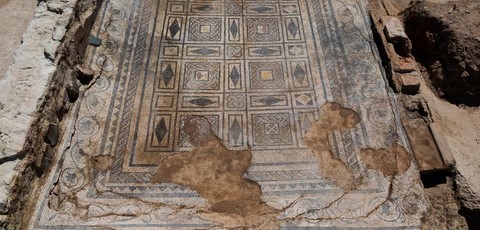Buried under ashes,a "Little Pompei" discovered near Lyon
In Sainte-Colombe, near Lyon (France), archaeologists have uncovered a whole suburb of ancient Roman Vienne during preventive excavation on a projected construction site. It’s an « exceptional site », « a little Pompei of Vienne », raves Benjamin Clément, the scientific leader of the operation.
The site, which was occupied during three centuries, is remarkabe by its expanse of nearly 7.000 sqm and by the diversity of the finds and their state of preservation. « A succession of fires allowed the preservation of all the elements in place, when the inhabitants ran away from the catatrophe, transforming the area into a real little Pompei of Vienne, » he exlaims.
The fire brought the top floor, the roof and the terrasse of a sumptuous dwelling to collapse, both caved in floors being preserved, with the furniture left in place. The house, dating from the the second half of the first century and surrounded by gardens, was baptised "House of the Bacchae" because of a mosaic with a cortege of bacchae surrounding a Bacchus.
With many others, a superb mosaic preserved in its near-totality in the "House of Thalia and Pan" has been lifted with much precaution earlier this week, to be restored at the ateliers of the gallo-roman museum of Saint-Romain-en-Gal. It shows Thalia, the muse of comedy, her buttocks bared, ravished by a lubricious god Pan.
The Roman city of Vienne, in Southeast France, was at a crossroads of communications, between the Rhône River and the Roman province of Gallia Narbonensis, on a "highway" connecting Lyon, the capital of Gaul, to the city of Arles. Another axis of circulation had most probably preceded it and the excavations «provide also an exceptional opportunity to analyze the anterior states of the Roman road of Gallia Narbonensis, or Transalpine Gaul, "one of the most important of this time."
.Begun in April, the excavations, carried out by some 20 specialists, was scheduled to end mid September. It has been prolonged until December 15, after having been rated « an exceptional discovey » by the French Ministry of Culture, according to Frédéric Letterlé, curator of archaeology for the region Auvergne-Rhône-Alpes, on a visit of the digs. The occasion for the archaeologists to excavate a zone of workshops and to access the most ancient levels of the site. « By digging further, we will probably discover more exceptional things. »
Besides the two luxurious houses, the neighborhood included shops dedicated to metalwork, food stores and other artisanal production; a warehouse full of jugs for wine; and a hydraulic network that allows for cleaning and drainage. The neighborhood appeared to be built around a market square, apparently the largest of its kind to be discovered in France.
Translated and adapted by Anne-Marie de Grazia



